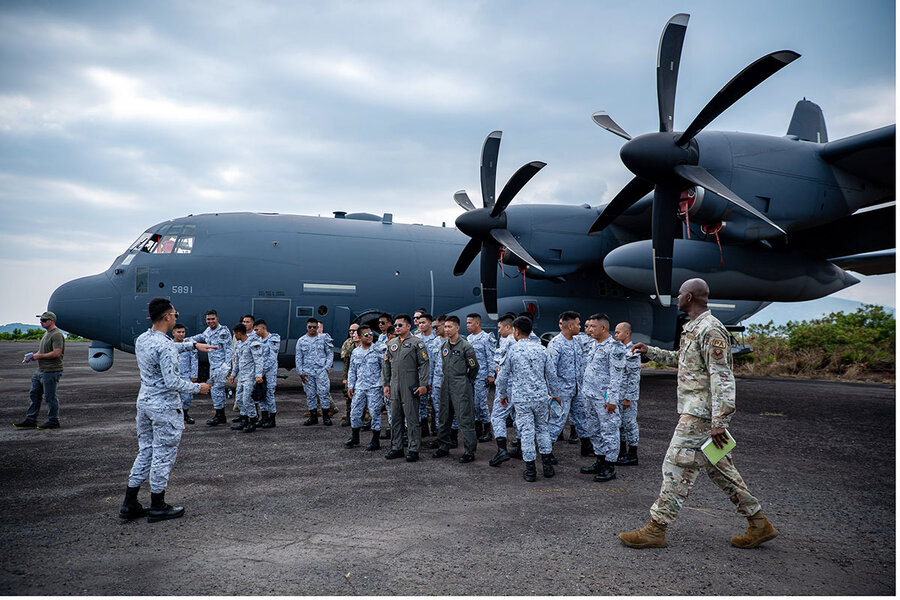In Philippines, joint military drills leave locals torn on US presence
Loading...
| SUBIC, PHILIPPINES
As the annual joint military exercises between the United States and the Philippines draw to a close, public opinion on U.S. military presence is divided.
This year’s Balikatan drills are the largest ever, involving more than 17,600 members of the two militaries, and come as the Philippine government seeks to temper China’s growing aggressiveness by deepening U.S. military cooperation. Just a few weeks before the joint exercises, Manila granted U.S. forces access to four additional military bases under the Enhanced Defense Cooperation Agreement (EDCA).
Why We Wrote This
A story focused onTo protect its interests in the South China Sea, the Philippines must delicately balance its relationship with China and the United States. But the government’s eagerness to boost U.S. military partnership has some Filipinos rethinking where that balance lies.
Most Filipinos are in favor of partnering with the U.S. and Japan to defend the country’s sovereignty in the South China Sea, but some say Uncle Sam’s presence is equally disruptive. Local fisherfolk complain that the “no-sail zone” implemented during the 18-day military exercises interfered with peak fishing season. Others, including Cagayan province governor Manuel Mamba, worry that increased U.S. military engagement could provoke conflict with China.
His province – which is only about 300 miles away from Taiwan and home to two new EDCA sites – “does not need to be involved in the quarrel of the superpowers,” he says. “What we need here are not foreign military troops, but foreign tourists and investors to bring economic growth in Cagayan.”
For years, fishing in the South China Sea has been both dangerous and difficult for Filipinos due to the increasing number of Chinese vessels encroaching on the Philippines’ exclusive economic zone – but recent military drills off the country’s western coast are giving some fisherfolk hope.
Leonildo Moralde, a commercial fisherman in Subic, Philippines, says access to the resource-rich lagoons and islets became harder under former President Rodrigo Duterte, who maintained a China-friendly posture throughout his term.
“We are hopeful that everything will improve because President [Ferdinand] ‘Bongbong’ Marcos Jr. is trying to balance the situation,” says Mr. Moralde. “Especially now that the government is more active in its engagement with the U.S.”
Why We Wrote This
A story focused onTo protect its interests in the South China Sea, the Philippines must delicately balance its relationship with China and the United States. But the government’s eagerness to boost U.S. military partnership has some Filipinos rethinking where that balance lies.
Subic, a former United States naval base, hosts the annual Balikatan (“shoulder-to-shoulder” in Tagalog) military exercises between the U.S. military and the Armed Forces of the Philippines. This year’s Balikatan, which began on April 11, is the largest ever, involving more than 17,600 members of the two militaries. As the 18-day drills draw to a close, public opinion on U.S. military cooperation is somewhat divided. Although most Filipinos are in favor of working with the U.S. to balance China’s influence in the region, some say Uncle Sam’s presence is equally disruptive, and could even escalate conflict with China. Manuel Mamba, governor of Cagayan province on the northern coast, worries that the increasing presence of U.S. forces may “put the country in a dangerous position.”
“We cannot harbor the enemy of our neighbor,” says Mr. Mamba, referring to China.
Trouble in Subic’s seas
In November last year, Mr. Moralde and his crew were driven away by three Chinese vessels in Scarborough Shoal in the South China Sea. “One of them was a Chinese Coast Guard ship,” Mr. Moralde claims, adding that the incident could have been “avoided if we had a military presence in the area.”
Jun Buenaventura, a businessman in Subic, hopes that U.S. forces visiting the country “will deter the Chinese from exploiting and abusing our natural resources.”
“It will make a difference if the American forces are present in our seas,” he says. “There is a balance of power if the U.S. is here, because the Philippine Coast Guard alone cannot protect our territory.”
According to the fisherfolk group Pamalakaya, many Filipinos have lost their livelihood because of China’s growing aggressiveness in the South China Sea in the past 10 years. Yet the group says the U.S. has also disrupted the livelihood of Filipino fishers by implementing a “no-sail zone” during the military exercises.
“Placing their fishing grounds under a no-sail zone just in time of the peak fishing season is highly unacceptable and detestable,” says Bobby Roldan, a fisherman in Masinloc and vice chairperson of Pamalakaya. The no-sail zone covers the coastal towns of San Antonio, San Narciso, San Felipe, Cabangan, and Botolan in Zambales province.
Renewed alliance
Thousands of U.S. and Filipino soldiers flocked to Subic Bay to participate in live-fire exercises – including, for the first time since the exercises started in 1999, sinking an actual ship. Mr. Marcos was also present, marking the first time in 12 years that the president has sat in on the joint military drills and signaling a commitment to deepening the U.S.-Philippines alliance.
Indeed, a few weeks before the conduct of the joint exercises, the Marcos administration granted the U.S. forces access to four additional military bases, in addition to five existing sites, under the Enhanced Defense Cooperation Agreement (EDCA). The U.S. defense department says the expanded defense agreement will allow the “seamless” response of the two militaries to the challenges in the region. Mr. Marcos is also set to meet U.S. President Joe Biden on May 1 at the White House to discuss economic and defense cooperation.
Rommel Ong, former vice commander of the Philippine Navy and a professor at the Ateneo School of Government, says EDCA sites are not U.S. bases like the Subic Bay naval base, which closed in 1992, but facilities for U.S. troops to immediately respond if the countries’ 72-year-old Mutual Defense Treaty is invoked.
Mr. Ong says that while military drills and defense cooperation with the U.S. help the Philippines “assess the state of its current capabilities and determine the gaps that need to be addressed,” Manila must unilaterally strengthen its armed troops and naval forces “to provide a holistic, whole-of-nation approach to archipelagic defense.”
Others point out that U.S. cooperation comes with risks. On April 14, Chinese Ambassador to Manila Huang Xilian accused the U.S. of taking advantage of the new EDCA sites “to interfere in the situation across the Taiwan Strait to serve its geopolitical goals and advance its anti-China agenda at the expense of peace and development of the Philippines.”
Mr. Mamba, the governor, believes the Philippines should scrap the expanded defense agreement. Cagayan province, which is only about 300 miles away from Taiwan and home to two new EDCA sites, “does not need to be involved in the quarrel of the superpowers,” he says. “What we need here are not foreign military troops, but foreign tourists and investors to bring economic growth in Cagayan.”
American inclinations
Despite fears of Chinese retaliation, many in the Philippines still welcome the U.S. presence. A Pulse Asia survey released in January indicated that 84% of Filipinos believe that the Marcos government should partner with the U.S. and Japan to defend the country’s sovereignty in the South China Sea.
Edison Palattao, a resident of Aparri in Cagayan, is one of those Filipinos. He says he’d rather see American soldiers based in the province “than Chinese vessels with Chinese crew dredging our rivers and sea.” In 2021, a Chinese vessel involved in alleged black sand mining destroyed Mr. Palattao’s fishing net.
This bias towards Americans is partly related to the country’s decadeslong history as an American colony. Compared to other Southeast Asians, it is easier for Filipinos to relate with the Americans “because we’ve been with them for over 100 years,” says Manuel Catral, a Catholic priest and a political analyst.
“We are greatly influenced by the U.S. from the songs we sing to how Filipinos run the government and the military,” he says. “But the most important matter is not how the country balances its relations with the U.S. and China, but how its foreign policies benefit or affect the Filipino people.”











